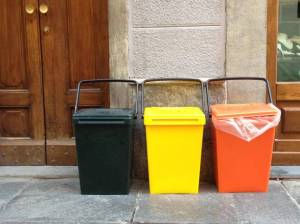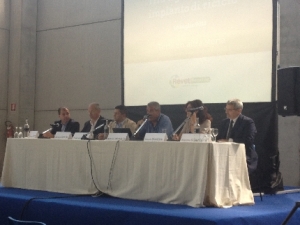This second travel break immediately followed the first travel break to Florence, with only three days of separation. It was the farthest away of all three of my travel breaks, riding on all possible methods of transportation sans an airplane: bus, train (x2), boat, and by foot. My travel partner and I spent an hour on a bus, took a 1½ hour train ride to Bologna, then hopped on another train for 2 hours to Venice. After that, we took a waterbus down the Grand Canal to a dock that was close to the hotel, then we walked through what seemed a labyrinth of “streets” to get to our hotel. Unlike Florence from the week before, filled with cars, mopeds, and bicycles, the only modes of transportation in Venice are by boat or by foot. That is because the streets are narrower than the smallest of cars, and each block ends with a stepped bridge over a canal. Here is a Venetian Taxi:
Our hotel, technically a hostel, was a narrow building with several stories of rooms all connected by a never-ending winding staircase. The floors were marble, adding a touch of elegance to the stigmatized concept of a hostel. We had our own room with two twin beds, a wardrobe, and our own bathroom, also a step up from the typical hostel. Here is the best view of the front, including the sign. I would have to walk on water to get a front-on view of the door. I’m still working on that… The most charming part of the hotel was a pigeon who apparently lived on our window sill. When my travel partner first opened the shutters to let in the sunlight, it startled the pigeon who flapped its wings haphazardly, and in the process scared my roommate half to death (she is afraid of all birds). The pigeon flew away for a second or two, but came right back to perch on the window sill. Charmed, I opened the glass window allowing fresh air in and to see how the pigeon would react. He stuck his head over the invisible barrier between our room and the window sill, looked around at us and all of our stuff we were unpacking, and then took a step back to just sit. Another pigeon saw what was happening, flew onto the window sill, and proceeded to walk into the room. The first pigeon shooed the second pigeon away, protecting his apparent territory and claiming his turf. I left the window open the entire three night and four day stay at that hotel, and that silly pigeon stayed right on that window sill. He never came in to my room, and I never tried to sit on his window sill.
The most charming part of the hotel was a pigeon who apparently lived on our window sill. When my travel partner first opened the shutters to let in the sunlight, it startled the pigeon who flapped its wings haphazardly, and in the process scared my roommate half to death (she is afraid of all birds). The pigeon flew away for a second or two, but came right back to perch on the window sill. Charmed, I opened the glass window allowing fresh air in and to see how the pigeon would react. He stuck his head over the invisible barrier between our room and the window sill, looked around at us and all of our stuff we were unpacking, and then took a step back to just sit. Another pigeon saw what was happening, flew onto the window sill, and proceeded to walk into the room. The first pigeon shooed the second pigeon away, protecting his apparent territory and claiming his turf. I left the window open the entire three night and four day stay at that hotel, and that silly pigeon stayed right on that window sill. He never came in to my room, and I never tried to sit on his window sill.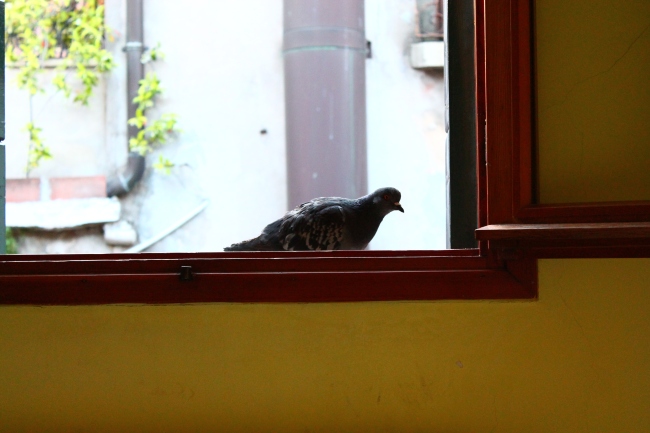
My travel partner planned to only stay one night with me, and then went on to her own adventures in Rome (I would later visit Rome for 3 days). For her one night in Venice, we went to a nice restaurant on an inner canal. Our waiter was an older gentleman who treated us like he was our grandmother, catering to our every need, and patting us on the head as he walked by as if he had known us our entire lives. This is what it looked like from the outside:

The next day, I walked my partner to the waterbus dock to see her off. After that I was alone and free to make all of my nerdy art historian visitation plans to as many cathedrals and museums as possible without compromises or distractions. I was on a mission. I made a plan to start at one end and move my way to the other end, zigzagging my way to each cathedral and museum that featured architecture or artwork that I had studied. However, my first stop was the farthest away, and after seeing my travel partner off at the dock, then stopping for souvenir shopping on the way, by the time I reached my first destination, the Frari Chapel, it was closing. Ugh. Well, that allowed me time to find a non-touristic piazza and check out the locals in full Venetian action. In the Campo Santa Margherita piazza there were Venetians of all types: mothers brought their children there to play, grandparents came to watch their grandchildren play, college students came to have a smoke and hang out with friends, older women and men came to walk their small dogs, old men came to have espresso with their lifetime friends (complete with full kissing both cheeks greetings), boys came to hang out with their girlfriends, other boys came to impress girls and find a girlfriend, and I came to watch it all unfold.
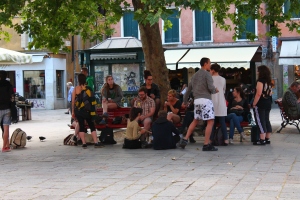
After getting my fill of people-watching, I made my way to the coast to find a suggested restaurant. I found it, but it was closed. So I decided to have a seat at the nearest café on the water which was serving gelato sundaes and fancy drinks. As soon as I sat down, I noticed that half the sky was dark and moving my way. I had heard that the rain in Venice can be nasty so I decided to make a run for my hotel to wait it out, change out of my day clothes and into dinner attire. The only problem was that I could not simply run to my hotel, I was on the other side of the Grand Canal! I had to go to the dock, keeping fingers crossed that the rain did not start until I was at least on the other side of the Canal. The entire process of going from the café to my hotel, although not very far apart geographically, took 45 minutes. I had to sit and wait for the waterbus to arrive, then while on the waterbus wait through several stops along the way to my own stop, then dash through the now familiar maze of streets, bridges, and alleyways to my hotel. I made it just in time to miss the downpour, and found myself wondering if all those other people who were still at the café were now caught in the rain. But then again, they probably weren’t a silly tourist on the wrong side (non-touristy side) of the Canal. I spent the rest of my evening reworking my plan and working out how to navigate the maze of Venice.
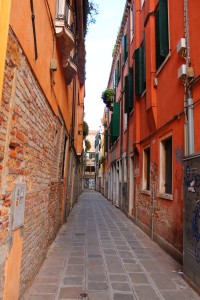

The next day I covered a lot of ground, visiting the Saint Mark’s Basilica, with a level of ornate that blew my mind. Everything was covered in texture, pattern, color, and sparkle. This is a cathedral that is a mix of Byzantine and Christian, otherwise known as Italo-Byzantine, covered in detailed mosaics of Christ and saints on the ceiling, strung with ornate lamps and lanterns over all of the many altars, and floors covered in sections of non-repeating tile patterns. I was overwhelmed. Tears filled my eyes but never fell. Feeling the need to have at least something other than memory to take with me (they would not allow pictures to be taken), I stood in front of a side chapel and sketched the altar and a few pendant lanterns. It’s not my best sketch, but it’s all I have other than my waning memory. This moment was perhaps the greatest advantage to being alone because taking the time to sketch didn’t mean others had to wait for me. I could take my time, be spontaneous, and be fully in-the-moment. I would strongly encourage any traveler to do it alone, or at least take full days apart from your group in order to follow your own instincts.

Then I made my way over to the Frari Chapel, making sure to get there early enough this time. The Frari Chapel features Titian’s famous Pesaro Madonna, his Ascension of the Virgin from 1518, and his own tomb, complete with a relief of his own Ascension painting. Also there was Giovanni Bellini’s Madonna and Child with Saints. But the piece that I am perhaps most excited about was a Pieta by an artist unknown to me, Pietro Guiseppe Tito.


This is by far the best Pieta ever made in my humble yet enthusiastic opinion. It embodies such raw emotion that cannot be ignored. The raw emotion of the scene is embodied in the raw treatment of the material, similar to the way Titian painted emotionally raw subject matter in his late years. The sculpture is rough on all sides with sharp edges, seemingly made by a series of scratches rather than smooth and refined. When I think of Michelangelo’s famous Pieta, I imagine that Tito’s Pieta is a representation of what Michelangelo’s mother Mary is feeling on the inside, yet not showing on the outside. Tito shows the human emotion; Michelangelo shows the divinity.
I also went to San Giorgio Maggiore, designed by Palladio, and featuring some impressive works by Tintoretto, including his Last Supper. There is also an Academia in Venice which is comparatively small, but features some impressive works nonetheless. I saw the San Giobbe Altarpiece by Giovanni Bellini (the same artist who painted the previously mentioned Madonna and Child with Saints), as well as his own Procession in San Marco piazza. This was quite a joy to view and compare the painting to the modern version of San Marco piazza which I walked through twice a day in average. I saw a very impressive La Pieta by Giambattista Cima de Conegliano, more paintings by Tintoretto including his glorious Deposition, the very large and fantastic Dinner in the House of Levi by Veronese among other impressive other that were new to me. I also was witness to Titian’s Pieta, his later version, as well as his Presentation of the Virgin to the Temple.
Although I was not in Venice to see modern art, it is my favorite kind of art, and I allowed myself the guilty pleasure of perusing the halls of the Peggy Guggenheim Museum which was right on the water, complete with a beautiful garden and courtyard with outdoor sculptures. After walking through Peggy’s collection, she and I are on a first name basis now; we became fast friends even though she is now deceased. Peggy and I are kindred spirits. The specific pieces of art that I love and are my favorites were collected by her long ago and put in this building for me to discover and fall in love, both with her and the art. Peggy, I love you. Please come back and be my friend for life (and let me live in your Venice museum). Besides all the Pablo Picassos, Jackson Pollocks, Max Earnsts, and Henry Moores, I was blessed with the presence of Unique Forms of Continuity in Space, by that blessed artist Umberto Boccioni.
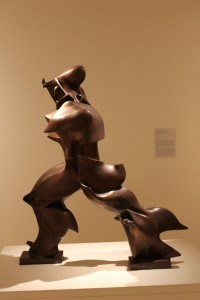


His sculpture before my eyes took my breath away in the same manner as when I saw the Florence Cathedral for the first time. I gasped for air, stifling my elation, snapping a million pictures as my only socially acceptable form of expression for a combination of pure childhood joy and humble reverence. I had to keep reminding myself to breathe. This sculpture embodies power, strength, grace, and fluidity of movement. He looks like a futuristic warrior, yet I can never quite decide if he looks on fire or made of water. I am in love with the abstraction which is certainly inspired by cubism. The body parts are exaggerated slightly, yet morphed into machine-like armatures. Plus, who doesn’t like a nice butt? He is some kind of samurai transformer from the future, and I could look at this for hours making myself dizzy from circling around it. As I was walking away from this Unique Form, I was filled up to tears (yes again) with gratitude. Thank you to everyone who donated funds, who encouraged me, and who supported me for giving me this moment. I will always remember the rollercoaster of emotions from simply seeing this sculpture, and will always be grateful for those who helped me to get here. This was a special exhibition that was not part of the permanent collection, and it was apparently meant to be for me to be at this place in this time.
And then I went to the Doge’s Palace, which had a special exhibition of Manet pieces. (Guilty pleasure modern art tour #2). Every single Manet piece that I had studied, and then some: Luncheon on the Grass, Olympia, The Fifer (although not specifically studied in class, this seemed to be a popular piece). The most charming paintings in the Manet exhibition were his portraits of his colleagues Clemenceau as well as his portrait of Berthe Morisot. I was charmed at the idea of one artist painting a portrait of his fellow painter friends. I think I would like to do this someday.
One interesting thing that I noticed while seeing both Titian and Manet paintings within days of each other was that Titian’s whites are of a very cool tone while Manet’s whiles are of a very warm tone. Nothing deeply philosophical to offer regarding that, I just thought that it was a bit interesting and made a note to self that I thought I would share.
Upon reflection, the most notable thing I drew from Venice is something that I had been witnessing all along in my time in Italy, but never really noticed until this time. All of those people in the local piazza were not there to do anything but visit and socialize with others. In America, when we get together with others, it always surrounds an activity of some sort. We eat dinner, or go to the movies, or go shopping, or grab a drink, or anything as long as we are DOing something. Italians don’t need to be engaged in a mutual activity to enjoy the company of others. They are just present. They show up, and sit down…and talk, nothing more. The talking IS the mutual activity. I must say I like this concept. I often find myself unable to have a meaningful conversation with a friend because we are both distracted with the activity we are doing together. I rather enjoy the idea of sitting and talking, and doing nothing else. Many of the college aged people were sitting and talking in the piazza; the mothers were gathered and talking while their children ran around and played; the old men were not playing chess, they were looking at each other and talking to each other. So why do we Americans multitask our relationships? Perhaps it is at the core of our drive for success, otherwise known as the search for the American Dream. We are a culture that places a high value on staying busy, to the point where people think there is something wrong with their lives if they do not have every day booked up with activities. What is wrong with doing nothing? It doesn’t seem productive, but, in fact it is. Doing nothing allows one to contemplate, to know one’s self, and to simply think. It is okay to do nothing while you contemplate things with a friend, to know them better, and think on things together without a plate of food or a movie screen or a rack of clothes for sale between the two of you. I rather embrace the idea of doing without the multitasking in order to give full presence to everything that I do. Now the real test is to see if my friends will get it…I rather think they will. I like to think that I tend to pick the good ones.

